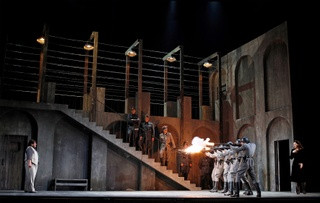|
Back
A descent into terror Melbourne
State Theatre
11/12/2014 - & November 15*, 18, 22, 26, 29, December 2, 5, 10, 13, 2014
Giacomo Puccini: Tosca
Martina Serafin (Tosca), Diego Torre (Cavaradossi), Claudio Sgura (Scarpia), Steven Gallop (Angelotti), Luke Gabbedy (Sacristan), Graeme Macfarlane (Spoletta), Adrian Tamburini (Sciarrone), Miro Lauritz (Shepherd Boy), Tom Hamilton (Gaoler)
Orchestra Victoria, Opera Australia Chorus, Opera Australia Children’s Chorus, Andrea Molino (Chorus Master and Conductor)
John Bell (Director), Michael Scott-Mitchell (Set Designer), Teresa Negroponte (Costume Designer), Nick Schlieper (Lighting Designer)

D. Torre & M. Serafin (© Jeff Busby)
Renowned founder of Australia’s Bell Shakespeare Company, director-performer John Bell brings an entirely new vision to Tosca, his first mainstage collaboration with Opera Australia. Mr Bell aims to “surprise people and recapture the original shock” which surrounded the premiere in 1900. He divests this ‘tried and true classic’ of a century of performance traditions and retells it as a tale of real people caught in situations which spiral out of their control amid barbarism and depravity.
Re-imagining and relocating the story to Rome in 1943, Bell causes gasps and flinches at the depths to which the newly-installed Nazi regime will resort while establishing control after Mussolini’s fall. We are visually assaulted by a blatant parade of swastikas through the church during the Te Deum; we are horrified at the Palazzo Farnese strewn with Nazi symbols; and we are confronted by a tormented assemblage of Jewish prisoners awaiting transportation in the final act.
Through the shock and terror, the drama in which Tosca and her lover become embroiled seems small and symbolic of the plight of the rest of the population. They are at the whim of Scarpia, a sadist who derives pleasure watching others squirm and plead. From Mario’s defiance of his torturer and Tosca’s haughty rejection of this sexual predator we see small glimpses of a higher human condition. However, it is eventually the might of the barbarian which will prevail and we discern that situations rapidly spin out of the protagonists’ control into the smirking grip of a monster.
On the third attempt after “releasing” Tamar Iveri following homophobic rants on social media and the recent indisposition of Svelta Vassileva, the title role was finally sung by Austrian Martina Serafin making her Australian debut. Ms Serafin is superbly confident and vocally produces some marvellous moments. Her Vissi d’arte is an absolute tour-de-force. Alone in Scarpia’s vast Art Deco headquarters, she collapses, desperately seeking an escape from her predicament but simultaneously confused and devastated by the turn events have taken. She is mesmerising in this scene and her voice is a gloriously powerful yet an intensely human instrument.
Mexican tenor Diego Torre’s Cavaradossi reflects the veracity of Bell’s vision of real people caught in unimaginable situations. He is affable, familiar and deeply committed to his work, his politics and the love of his life. Mr Torre commands absolute attention when he sings. His voice is subtle and velvet-toned juxtaposing gentle humour against massive power and passion in this wide-ranging interpretation.
As Scarpia, Italian Baritone Claudio Sgura plumbs the depths of Bell’s depiction of absolute evil. Driven by sexual desire from which no woman is safe, he gropes and fondles his hapless secretary in view of his colleagues, revelling in her disgust and helplessness. Mr Sgura has a massively powerful and rich voice. He soars above the Te Deum and whispers his threats to Tosca in Act 2 as gently as a lover. This character is magnificently realised.
Returning to Opera Australia, Andrea Molino conducts Orchestra Victoria in a towering performance. They achieve wonderful variation in tone from gentle humour and playfulness in the first act to driving inevitability in the final scene. Their accompaniment of the major solo pieces was exemplary: subtle, light of touch and driving the passion of the music. This performance was greatly admired receiving rousing accolades from the capacity audience.
Michael Scott-Mitchell’s set design and costumes by Tessa Negroponte work perfectly in accord with John Bell’s vision. The gorgeous, lofty walls of Sant’Andrea della Valle are a reference from a grander age against the austere grey uniforms of the Nazi regime and the fashionable but utilitarian clothing of the worshippers. The children in uniforms reminiscent of Hitler Youth are a disturbing clash and the appearance of the huge swastika flags jarred, directing attention to Scarpia as he emotes at the end of Act 1, “you make me forget God”.
Palazzo Farnese became an Art Deco monument to the power of the regime. In greys and black, it is dominated by huge red swastika banners one of which Cavaradossi tears from the walls in contempt, little-knowing that it will soon be used by Tosca to cover the face of her tormentor’s body. She repays Scarpia’s brutality with multiple stabbings, spitting on his corpse before she flees. These are shocking scenes which stunned the audience. The roof of the Castel Sant’Angelo became a lonely platform encased by stone walls, dominated by a barbed-wire enclosed guard-walk and harsh prison lights. At first, we witness brutal harassment of Jewish prisoners as they are herded towards transportation but eventually, the austerity and loneliness of the set bear witness to Mr Torre’s heart-wrenching delivery of E lucevan le stelle.
John Bell alters the ending of the opera to shock and poignantly underline the desperation which has grown throughout its latter stages: Tosca, in a frantic attempt to escape the Nazi troopers, flees upstairs to the guard walk. Tearing at the barbed wire and unable to throw herself from the parapet, she confronts her assailants who open fire with machine guns as the curtain falls.
This is a riveting Tosca. Gone are powdered wigs and flowing gowns, replaced by terrifying visions of life under the Nazi regime. This is relevant; this is real and above all, this is intensely human.
Gregory Pritchard
|